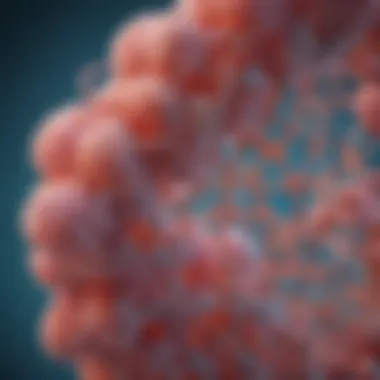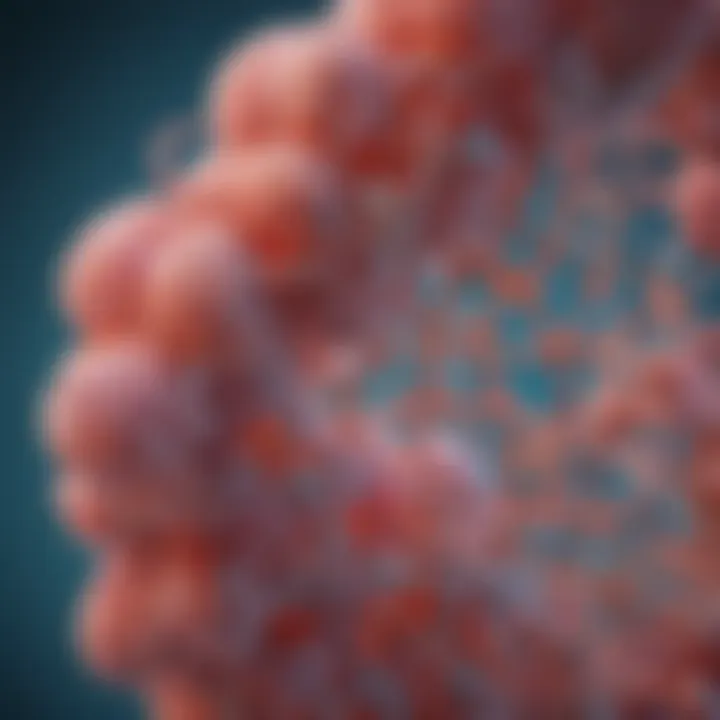Exploring Noggin Protein: Structure and Developmental Roles


Intro
Noggin protein has become a focal point of research in developmental biology due to its unique properties and roles. This protein, originally identified for its function in neural development, holds significance far beyond this initial discovery. This article investigates noggin's structure, function, and implications in various biological contexts. The aim is to present a coherent narrative that unpacks the complexities and relevance of noggin.
Research Overview
Summary of Key Findings
Noggin is a glycoprotein that modulates bone morphogenetic protein (BMP) signaling. This modulation is essential for various aspects of development, particularly in the formation of the nervous system. Research has shown that noggin interacts with BMPs, inhibiting their activity and thereby influencing cellular commitment and differentiation. Recent studies uncover noggin's role not only in embryonic development but also in adult tissue maintenance and regeneration.
Furthermore, noggin’s therapeutic implications have garnered attention. For example, manipulating noggin levels in specific conditions can promote healing processes in tissues that commonly suffer from degeneration. The interaction between noggin and signaling pathways opens a multitude of potential applications in regenerative medicine.
Relevance to Current Scientific Discussions
The ongoing debate in developmental biology centers on how molecular signals shape tissue differentiation and organogenesis. Noggin's pivotal role in this context places it at the intersection of various scientific discussions. Notably, the implications of noggin's action offer insights into congenital disorders and neural tube defects. Understanding how noggin functions can help pave the way toward targeted therapies for such conditions.
Methodology
Research Design and Approach
Research into noggin has employed a variety of experimental designs, often utilizing in vivo and in vitro models. Studies have examined developmental processes in model organisms such as Xenopus laevis and Mus musculus. This approach allows for the dissection of noggin's function in a controlled environment, while also considering its broader biological relevance.
Data Collection and Analysis Techniques
Data collection typically includes molecular assays and genetic manipulation techniques. Researchers frequently utilize techniques such as quantitative PCR and Western blotting to assess noggin expression levels. Additionally, imaging techniques such as immunofluorescence and confocal microscopy are employed to visualize noggin's localization within tissues. This combination of qualitative and quantitative methods ensures a comprehensive understanding of noggin's dynamics within biological systems.
Understanding noggin's interaction with BMPs is crucial for unraveling the complexities of neural development.
Through this structured exploration, the subsequent sections will delve deeper into noggin's intricate structure and its multifaceted functions, ultimately shedding light on its implications for future research.
Prelims to Noggin Protein
The exploration of noggin protein is significant in understanding various biological processes. This protein plays a crucial role in development, particularly in neural systems. Its implications stretch from embryonic development to potential therapeutic applications. A comprehensive examination can enlighten many aspects of developmental biology.
Overview of Noggin
Noggin is a highly conserved protein known for its pivotal role in signaling pathways. It functions primarily as an antagonist to bone morphogenetic proteins (BMPs), which are key players in mesoderm and neuroectoderm differentiation. By inhibiting BMP activity, noggin helps regulate several developmental processes. Studies have shown that the presence of noggin is vital for proper neural patterning during early embryogenesis. The protein shows a unique structure, comprised of several cysteine-rich domains, which allows it to bind tightly to BMPs.
In humans, mutations in the noggin gene can lead to several congenital disorders, further emphasizing its importance in developmental biology. Its abundance in tissues during early development highlights its role in orchestrating the growth and differentiation of various cell types.
Historical Perspective
The discovery of noggin dates back to the mid-1990s when researchers first identified it in chick embryos. Its name originates from the archaic term used in a significant genetic study involving Drosophila. The initial findings indicated noggin's role as a BMP inhibitor. Since then, numerous studies have confirmed its functions across different species.
Research has expanded over the years, revealing noggin's involvement in various critical processes like neural development and organogenesis. Notably, its implications in pathologies, such as certain genetic disorders and cancers, have become a vibrant area of investigation.
In summary, the history of noggin protein reflects the continual advancement in our understanding of developmental mechanisms. From an initial identification to its current recognition as a key player in various biological functions, noggin remains a focal point for researchers dedicated to unraveling complex developmental processes.
Molecular Structure of Noggin
The molecular structure of noggin is fundamental to understanding its role in both neural development and its various biological functions. This section will dissect the intricate aspects of noggin’s primary, secondary, and tertiary structures, as well as its post-translational modifications. Each of these facets provides insight into how noggin operates within cellular environments and influences various signaling pathways.


Primary Structure
The primary structure of noggin refers to its unique amino acid sequence. Specific variations in this sequence can greatly affect the protein's functionality. Noggin is composed of a set of cysteine-rich domains that are critical for its interaction with other proteins, particularly bone morphogenetic proteins (BMPs). Cysteine residues form disulfide bonds essential for maintaining the protein's stability.
Specific studies show that subtle changes in the sequence can lead to different binding affinities, which in turn can impact noggin's efficiency in inhibiting BMPs. These binding characteristics are crucial for its role in preventing premature bone formation during embryonic development. Understanding the primary structure offers a glimpse into potential therapeutic applications, particularly if modified forms of noggin can be engineered for enhanced interaction with BMPs.
Secondary and Tertiary Structure
The next layer of complexity is found in the secondary and tertiary structures of noggin. The secondary structure is largely characterized by alpha-helices and beta-sheets, which contribute to the overall stability of the protein. These structures are vital as they create an intricately folded conformation, essential for noggin's function.
The tertiary structure involves the three-dimensional arrangement of the secondary structural elements. This configuration allows noggin to form its active sites, which are key for its biological interactions. Many studies use techniques such as X-ray crystallography and nuclear magnetic resonance (NMR) to elucidate these structures. By understanding the spatial arrangement of its amino acids in the tertiary structure, researchers can predict how noggin might interact with other proteins.
Post-translational Modifications
Post-translational modifications (PTMs) of noggin are critical in regulating its activity and stability. These modifications can include glycosylation, phosphorylation, and proteolytic cleavage, which can affect its solubility and bioavailability. For instance, the addition of carbohydrate groups through glycosylation helps noggin achieve the proper folding necessary for function. Such changes can modulate noggin’s interaction with receptors, thus influencing its inhibitory effect on BMP signaling.
Research has shown that differing patterns of PTMs can alter noggin's function significantly in different biological contexts. Understanding these modifications is crucial for identifying how noggin can be manipulated for therapeutic purposes. The varying stability and bioactivity resulting from PTMs can have profound implications for developmental biology research.
"The understanding of noggin’s molecular structure paves the way for innovative approaches in treating developmental disorders and diseases involving aberrant BMP signaling."
Functional Aspects of Noggin
Understanding the functional aspects of noggin is crucial for appreciating its significance in developmental biology. Noggin plays a key role in several biological processes, particularly related to neural development and skeletal formation. Its functions include inhibition of specific signaling molecules and interaction with other proteins that are essential for normal cellular activities. The exploration of these functions sheds light on how noggin contributes to the intricate balance of signaling pathways in development.
Role in Neural Development
Noggin is a vital player in the development of the central nervous system. It achieves this by antagonizing the bone morphogenetic protein (BMP) signaling pathway, which has been shown to play a dual role in neural development. High BMP levels can lead to the formation of non-neural tissues, while low levels promote neural differentiation. Thus, noggin’s role as an inhibitor of BMP is significant.
- Promotion of Neural Induction: Noggin facilitates the process of neural induction, allowing precursor cells to commit to a neural fate. Studies suggest that noggin is expressed in the embryonic notochord and is necessary for the induction of surrounding ectoderm to form neural tissues.
- Neurogenesis and Patterning: Through the antagonizing of BMP signals, noggin helps establish the correct spatial and temporal gradients needed for neurogenesis, leading to proper brain and spinal cord formation. This regulation is essential for the growth and patterning of the neural tube during early embryonic development.
Inhibition of Bone Morphogenetic Proteins (BMPs)
Noggin predominantly functions as an antagonist to BMPs, a group of proteins that promote bone and cartilage development. Because BMPs are critical in both the differentiation of mesodermal tissues and maintaining the balance of other signaling pathways, noggin is vital. It binds to BMPs, preventing them from activating their receptors, thus inhibiting their activity.
- Effect on Chondrogenesis: By inhibiting BMPs, noggin promotes chondrogenesis, which is essential for proper skeletal development. This balance allows cartilage to develop appropriately without premature calcification.
- Impact on Osteogenesis: Conversely, the inhibition of BMP signaling by noggin affects osteogenesis negatively. Too much noggin could hinder bone formation, demonstrating the need for tight regulation of noggin levels throughout development.
Interplay with Other Signaling Molecules
The functional reach of noggin extends beyond just BMP inhibition. It interacts with a wide array of signaling molecules, indicating its role in a more complex network of cellular communication. For example, noggin also has interactions with Wnt and FGF signaling pathways.
- Wnt Signaling: Wnt signaling is known for its implications in cell communication, differentiation, and embryonic development. Noggin's role here appears to modulate the effects of Wnt, potentially guiding cells towards particular developmental pathways amidst competing signals.
- FGF Pathway: Similar to Wnt, fibroblast growth factors (FGFs) are crucial for various developmental processes. Noggin may influence FGF signaling by modifying the local concentrations of BMPs, demonstrating its integrative role in signaling dynamics.
Understanding how noggin interacts with these pathways is fundamental since it could reveal novel mechanisms governing embryonic development.
These functional aspects of noggin not only underline its importance in neural and skeletal development but may also open avenues for further investigation into its potential therapeutic applications. Understanding how noggin functions highlights the necessity for balance in signaling pathways essential for proper development.
Noggin in Developmental Biology
The examination of noggin in developmental biology is pivotal in understanding how this protein influences critical stages of biological growth and organ formation. Noggin plays a substantial role in mediating cellular processes that result in the proper development of tissues and organs. Its multifaceted functions underline its significance, not only in a healthy developmental context but also in understanding various pathologies associated with abnormal development.
Embryonic Development


In embryonic development, noggin is essential for the formation of the neural plate and the neural tube. This critical phase sets the foundation for the entire nervous system. Noggin achieves this by antagonizing the bone morphogenetic proteins (BMPs), which are known to promote neural crest differentiation. By inhibiting BMP signaling, noggin allows the neural tissues to differentiate properly without interference. Additionally, noggin’s role in the anterior-posterior axis specification highlights its necessity in establishing the organism's structural architecture during early development.
Recent studies suggest that noggin operates by forming complexes with BMPs. This action not only prevents their interaction with receptors on the cell surface but also facilitates the uptake of other signaling cues crucial for embryonic growth. Thus, the absence or dysfunction of noggin during this phase can lead to severe malformations and neural tube defects, which have been widely documented in independent research.
Impact on Organogenesis
Analyzing noggin's impact on organogenesis reveals its functional importance across various organ systems. During organ development, noggin contributes to the formation and patterning of several structures, including the heart and limbs. By modulating BMP activity, noggin plays a role in the proliferation and differentiation of progenitor cells, ensuring the correct size and functionality of organs.
In limb development, noggin limits the action of BMPs that promote bone growth, thus maintaining a balance between cartilage and bone formation. Interestingly, noggin expression is regulated spatially and temporally to ensure that this balance is achieved. Aberrant expression levels of noggin can disrupt normal limb formation, leading to conditions such as syndactyly or limb malformations.
Additionally, noggin's involvement extends to other organs, like the kidney, where it aids in nephron patterning. The protein's ability to restrain BMP signaling is crucial for the early development of kidney structures, underscoring its role as a central player in organogenesis.
"The functionality of noggin during organogenesis emphasizes its necessity not just for growth, but for the precise spatial and temporal coordination of signaling pathways that shape the final organ structures."
Pathological Implications of Aberrant Noggin Activity
The study of noggin protein extends beyond its essential role in development; it also encompasses the critical examination of how deviations in noggin activity might contribute to various pathologies. Aberrant noggin activity has been implicated in a range of conditions, particularly in cancer progression and genetic disorders. Understanding these implications forms a pivotal part of comprehending noggin’s overall biological significance and potential as a therapeutic target.
Role in Cancer Progression
Noggin is considered a critical modulator in tumor biology. Its involvement in the inhibition of bone morphogenetic proteins (BMPs) is of significant interest. When noggin activity is dysregulated, it often leads to unchecked BMP signaling, which can promote tumorigenesis.
- In many cancers, high levels of BMP signaling are associated with aggressive tumor behavior, promoting cell proliferation and reducing apoptosis.
- Aberrant noggin expression has been observed in various cancers, including gliomas and breast cancer. This misregulation might provide cancer cells with a survival advantage, facilitating metastasis and recurrence.
Recent studies have highlighted the potential of noggin as a diagnostic marker due to its altered expression in cancerous tissues compared to normal tissues. This aspect could pave the way for further research into targeted therapies that restore normal noggin function, potentially inhibiting tumor progression.
"Understanding noggin's role in cancer could lead to innovative strategies for cancer treatment."
Association with Genetic Disorders
Genetic disorders associated with noggin include skeletal abnormalities and other congenital malformations. Mutations or dysregulation of noggin can disrupt normal developmental processes, leading to conditions such as:
- Craniosynostosis: A condition characterized by the premature fusion of skull bones, which can impact brain development.
- Spondylocostal Dysostosis: A genetic condition that affects the vertebral column and ribs, often resulting in significant physical challenges.
These conditions underscore the importance of noggin in maintaining proper signaling pathways during embryonic development. Understanding how alterations in noggin lead to these disorders is crucial for developing potential strategies for diagnosis and management.
Research into noggin-associated genetic disorders highlights the need for ongoing inquiry into the molecular mechanisms that underlie these pathologies. This can not only inform better therapeutic approaches but also potentially identify novel targets for intervention in related conditions.
In summary, the consequences of aberrant noggin activity reveal its vital role in both cancer and genetic disorders. This understanding can lead to significant advancements in the methods we use to diagnose and treat conditions associated with noggin dysregulation.
Noggin as a Therapeutic Target
The designation of noggin as a therapeutic target stems from its critical roles in various biological processes, particularly in developmental biology. Its unique ability to modulate signaling pathways makes noggin an intriguing candidate for therapeutic interventions. Understanding the mechanisms by which noggin influences cellular behavior is paramount to harnessing its potential in treating diverse conditions.
Potential in Regenerative Medicine
Noggin has shown promise in regenerative medicine due to its ability to inhibit bone morphogenetic proteins (BMPs). This inhibition is significant because BMPs are pivotal in bone formation and tissue repair. By controlling BMP activity, noggin can help regulate the differentiation of stem cells into specific cell types, which is essential in regenerative therapies.
Investigations into the application of noggin in stem cell therapies highlight its potential to enhance tissue healing and regeneration. Techniques such as preconditioning stem cells with noggin before transplantation could improve outcomes in conditions like spinal cord injuries or heart diseases. Current studies suggest that noggin can facilitate the repair process by promoting proper cellular organization, which further underscores its relevance in tissue engineering.
Implications for Disease Treatment


In the context of disease treatment, noggin’s role extends into therapeutic strategies for cancer and genetic disorders. Its involvement in signaling pathways that govern cellular growth and differentiation positions noggin as a candidate for targeted therapies. For example, aberrant noggin activity can lead to tumor progression, making its modulation crucial in cancer treatment strategies.
Moreover, diseases characterized by dysregulated bone homeostasis, such as osteoporosis, could benefit from noggin-targeted therapies. By restoring normal noggin function, it may be possible to correct the imbalances within the BMP signaling pathways involved in bone density regulation.
"Modulating noggin levels could provide a dual approach in treating both cancer and bone-related disorders by targeting the underlying signaling disruptions."
The exploration of noggin as a therapeutic agent opens numerous avenues for future research. Identifying safe and effective strategies to manipulate noggin levels may lead to groundbreaking treatments across various medical fields, highlighting an important intersection of developmental biology and therapeutic applications.
Research Advances and Innovations
Research on noggin protein has led to significant advances in our understanding of its role in developmental biology. Recent developments highlight not only the molecular structures and functions of noggin but also its potential implications in various therapeutic contexts. As our knowledge grows, the significance of noggin research becomes increasingly evident, prompting further investigation into its applications and interactions.
Recent Discoveries
In the past few years, several key discoveries regarding noggin have emerged. One notable finding is the detailed understanding of noggin's interactions with Bone Morphogenetic Proteins (BMPs). Researchers have shown that noggin functions as an antagonist to BMP, elucidating its critical role in regulating cellular differentiation and signaling pathways during development. This antagonistic activity has opened up new discussions regarding its implications in both normal physiological processes and pathological conditions.
Additionally, studies using advanced imaging techniques have revealed noggin's precise actions within cellular environments. For example, live-cell imaging has splayed how noggin interferes with BMP signaling in real-time, enhancing our understanding of its time-sensitive roles during embryogenesis.
Furthermore, genetic studies have identified specific mutations in noggin that correlate strongly with various developmental disorders. These include conditions such as skull malformations and certain neurodevelopmental disorders. Such correlations provide a clearer picture of noggin’s importance beyond mere structural functions, indicating its potential as a biomarker for certain genetic conditions.
Technological Approaches in Noggin Research
Technological advancements have significantly propelled noggin research forward. CRISPR-Cas9 genome editing technology, for instance, has been pivotal in generating models to study noggin's genetic influences. By creating precise alterations in noggin genes, researchers are able to observe resultant phenotypic changes in vertebrate models, such as zebrafish and mice. This has not only validated prior theories regarding noggin's role but also unveiled new aspects of its function and regulation.
Moreover, proteomics and transcriptomics have been utilized to study the broader effects of noggin within various signaling networks. High-throughput sequencing techniques have allowed researchers to assess gene expression profiles affected by noggin. This provides insights into how noggin participates in complex biological processes and its feedback mechanisms in developmental biology.
"The exploration of noggin protein goes beyond the basic science; it holds promise for innovative therapies and understanding of genetic disorders."
The intricate relationship between noggin and various biological processes underscores the need for continued research and technological investment. As this field evolves, so too does the potential for integrating these findings into practical applications.
Epilogue
The conclusion serves as a critical element of this article, synthesizing the intricate findings related to noggin protein's role in developmental biology. The evidence presented throughout demonstrates noggin's multifaceted functions and its central role in various biological processes. By summarizing the key findings, this section reinforces the significance of noggin, especially in the contexts of neural development and its interactions with signaling pathways.
Understanding noggin's structure and actions opens avenues for further research and therapeutic innovations. Its ability to inhibit bone morphogenetic proteins poses a chance for advances in regenerative medicine and disease treatment. Moreover, awareness about noggin's implications in cancer and genetic disorders highlights the necessity for continued investigation.
Summary of Key Findings
- Structural Characteristics:
- Functional Roles:
- Pathological Connections:
- Therapeutic Potential:
- Noggin has a distinctive molecular structure that allows it to bind effectively to BMPs, inhibiting their functions.
- The protein plays a crucial role in neural development and organogenesis.
- Aberrant noggin activity is linked with cancer progression and genetic disorders.
- Targeting noggin offers possibilities in regenerative medicine and potential pathways for treatment of related diseases.
"The significance of noggin protein extends beyond development; it is a pivot in understanding various pathological states and therapeutic avenues."
Future Directions in Research
Future studies should focus on several key areas:
- Mechanisms of Action: Investigating the specific molecular pathways impacted by noggin will provide deeper insights into its functions.
- Therapeutic Applications: Continued research into drugs that manipulate noggin activity may yield new treatments for cancers and genetic disorders.
- Experimental Models: Development of advanced experimental models will aid in elucidating noggin's role across different biological contexts.
- Clinical Implications: Studies exploring the clinical relevance of noggin levels in patients could inform treatment protocols in oncology and regenerative medicine.
In summary, noggin protein emerges as a vital player across numerous biological fields. Further exploration will enhance our understanding and possibly lead to groundbreaking therapeutic strategies.



